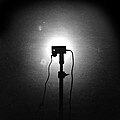Equidensites
Equidensites , also isodensites , designate points, areas or lines of equal blackness in a halftone photographic original.
- Equidensites made from halftone images are called first-order equidensites and reflect a certain density of the original.
If a statement is to be made about a very limited range of density, it is often sufficient to produce individual equidensites that are first-order equidensites from the type of production. - Equidensites made from first-order equidensites are called second-order equidensites and represent two specific densities of the original.
- An equidensitic array captures several ranges of density in one image. For this purpose, transparent excerpts of the created equidensites are made, which are then precisely fitted on top of each other. These separations can be colored by chromogenic development , which creates a color key , with each color representing a specific density range.
In some cases, there are methods for producing them that are difficult to control and difficult to reproduce, namely:
- The single-plate method, better known as the Sabattier effect or pseudo-solarization
- The two-plate process, also better known as tone separation or negative / positive process
- The scattered light method, the Tyndall effect is used
- Electronic process, whereby video conversion tables transform gray tones into colored or gray areas
- "Agfacontour Professional" (a commercial single-plate process, see below)
- Today also with the help of digital image processing using the curve function
Pseudo-solarization causes a partial reversal of the tone gradient . As a result, different object brightnesses are assigned to the same gray values. The more jumps the tonal value correction has, the more lines of equal brightness appear on the image. The higher the brightness gradients , the closer the equidense lines are .
An equidensitic film developed by Agfa-Gevaert and marketed in 1970 under the name Agfacontour Professional brought great simplification and reproducibility . This film was available as sheet film in the usual formats and enabled the direct production of equidensites in a simple manner.
Equidensites are important for various evaluations using electronic and photographic methods:
- astronomy
- Electron microscopy
- Plasma technology
- Interferometry
- Radiology e.g. B. Mammography (sites of equal absorption)
- Autoradiography (sites of the same radioactivity )
- Thermography (places of the same temperature )
- Evaluation of recordings in the stress optics
- Interpretation of aerial and satellite images (places of the same reflection, same growth, same geological structure, etc.)
See also
- Kurt Dieter Solf: Equidense film. In: Photography. Fischer Taschenbuch Verlag, Frankfurt am Main 1973, ISBN 3-436-01453-2 , pp. 111-118.
- H. Mass: Agfacontour Professional in practice. In: Photo technology and economics. No. 2, 1971, p. 39.
- KW Junge: Basics of photographic chemistry. In: Gerhard Teicher (Hrsg.): Handbook of the photo technology. 6th edition. VEB Fotokinoverlag, Leipzig 1974, pp. 76-77.






